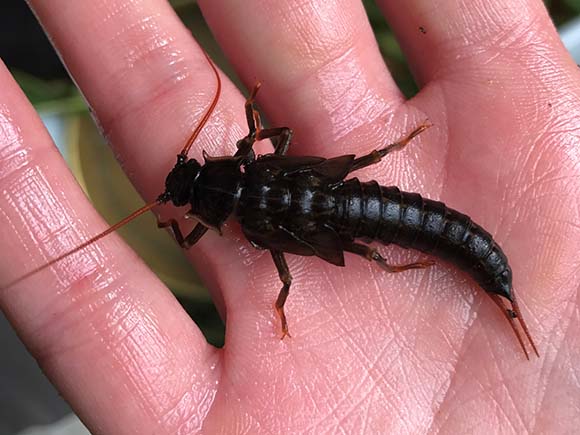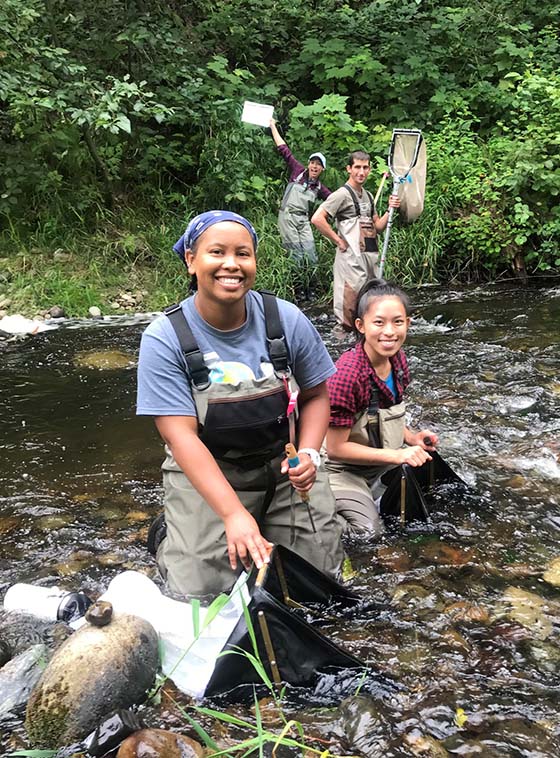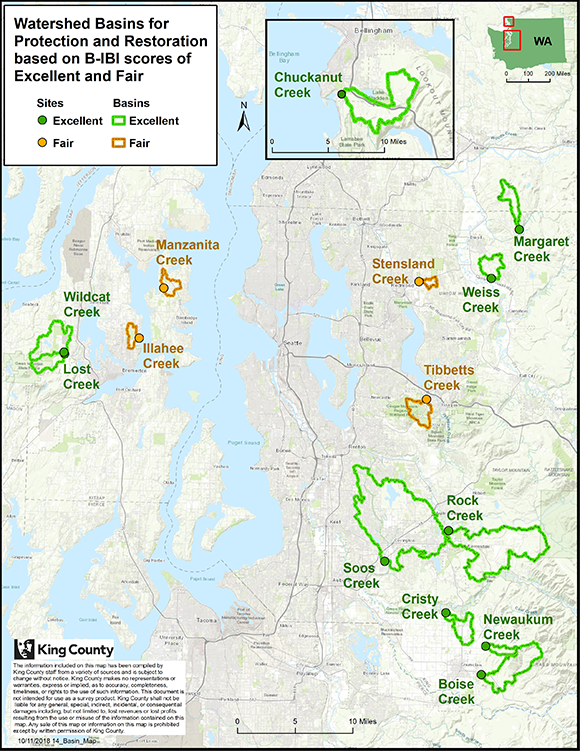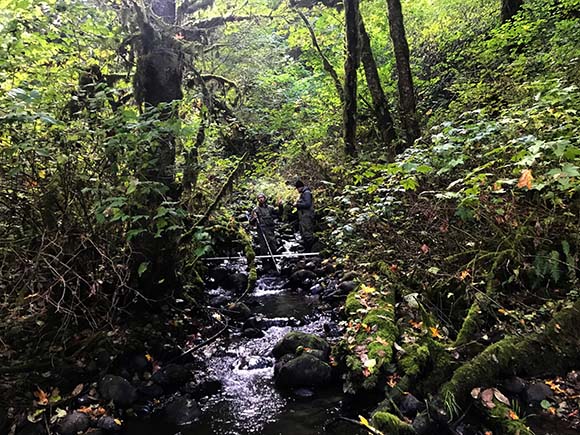The Restore and Protect Project
Identifying and recommending actions to restore and protect local streams
The Restore and Protect Project focuses on protecting and restoring Puget Sound streams. It addresses the Puget Sound Partnership (PSP) recovery goals for improving freshwater quality. This project is part of a phased effort, and this report reflects work done in the second of five phases. Strategies for Preserving and Restoring Small Puget Sound Drainages was the first phase.
Streams are essential natural resources for humans and animals alike. Many animals that need healthy streams are sensitive to water and habitat quality. This is true for well-known species like salmon. But it is also true for the insects, worms, snails and other small critters that live on the bottoms of streams. These smaller animals, are often called “stream bugs”. They are excellent indicators of water quality and overall stream health. The number and types of stream bugs present at a site provides us with the big picture of how a stream is doing. This data can also show what actions can help meet our restoration and protection goals.

Goals
This phase of the project seeks to advance the PSP's goal of restoring and protecting Puget Sound. The project focuses on a select group of 14 streams. We chose four “fair” streams in need of restoration and 10 “excellent” streams in need of protection. We selected these sites for their potential to improve or maintain high scores. In these streams, we sought to identify human activities that impact stream health. Based on that, we sought to recommend actions that restore and/or protect these stream basins.
This project looks at the Puget Lowland Benthic Index of Biotic Integrity (B-IBI). The B-IBI is one of PSP’s Freshwater Quality indicators. This index characterizes stream health based on the variety of stream bugs present at a site. The B-IBI scoring system categorizes streams as “very poor” to “excellent,” on a scale of 0-100. More details about the B-IBI scoring system are on the Puget Sound Stream Benthos website.

Selected basins
Using regional stream bug data, we chose 10 healthy basins and four degraded basins. The healthy basins are in need of protection. The degraded basins are in need of restoration.
“Fair” (degraded) sites include:
- Illahee Creek, Kitsap County, Water Resource Inventory Area (WRIA) 15
- Manzanita Creek, City of Bainbridge Island, WRIA 15
- Stensland Creek, King County, WRIA 8
- Tibbetts Creek, City of Issaquah, WRIA 8
“Excellent” (healthy) sites include:
- Lost Creek, Kitsap County, WRIA 15
- Wildcat Creek, Kitsap County, WRIA 15
- Chuckanut Creek, Whatcom County, WRIA 1
- Margaret Creek, King and Snohomish Counties, WRIA 7
- Big Soos Creek, King County, WRIA 9
- Weiss Creek, King County, WRIA 7
- Rock Creek, King County, WRIA 8
- Cristy Creek, King County, WRIA 9
- Newaukum Creek, King County, WRIA 9
- Boise Creek, King County, WRIA 10

Identifying stressors
Identifying specific stressors affecting stream communities is challenging. Many stressors known to impact streams co-occur in stream basins as they urbanize. These include excess fine sediment, loss of streamside vegetation, and "flashy" flows. "Flashy" refers to how fast flow in a stream increases and decreases in a storm.
In this study, we identified potential stressors affecting each basin. We used data from field surveys and a variety of geospatial data. With this information, we characterized conditions at the local, riparian and basin scales. We then compared those to conditions we find in other stream basins.
To provide context, we examined the relationships between environmental conditions and B-IBI scores. To do this we used data from a larger pool of sites within the Puget Sound basin. These conditions include substrate size, forest cover, density of roads, and many others. Then, for each condition, we calculated points at which degradation happens. We refer to these points as thresholds. This lets us see how stream health changes in response to different kinds of stressors.
We calculated thresholds using two different approaches. First, we examined how individual sensitive stream bug species respond to degraded conditions. Second, we characterized typical sites with “excellent” B-IBI scores for each condition. We compared these thresholds to conditions in each study site.
What did we find?
Our results agreed with those of other similar studies. Many related factors likely impact stream health and B-IBI scores. These factors are generally associated with urbanization and loss of forest. Urbanization in the basin impacts stream bugs more than any single stressor.
At all “fair” sites, we found many degraded conditions. Generally, conditions were most affected at the basin and riparian scale. In some cases, conditions were less affected at the local scale. This shows that basin-scale conditions affect B-IBI scores more than site-scale. This result is in agreement with the results of other similar studies.
As expected, conditions at “excellent” sites were better than those at the “fair” sites. But, we also found evidence of many degraded conditions at most “excellent” sites. This suggests two possibilities. Stream bug communities could have some resilience to degraded conditions. Or, the impact of the degraded conditions may be time-lagged. If so, their “excellent” status may be tenuous.

Recommended restoration and protection actions
In "fair" streams, we recommend better stormwater management and forest health. This looks like:
- protecting intact forestland;
- establishing more forest cover;
- increasing the density of vegetation in, and the width of, riparian buffers;
- controlling and treating stormwater as much as possible.
We recommend addressing stressors affecting conditions at the basin and riparian scale first. Conditions at the site level are often the result of problems in the basin or in the riparian buffer. Excess fine sediment is an example. Restoration actions that resolve the source of the problem can improve local conditions.
Recommendations for protecting “excellent” basins were variable and dependent on basin-specific conditions. Some basins were quintessential “excellent” basins that exhibited almost no degraded conditions. These had consistent “excellent” B-IBI scores. In these basins, we recommend protecting forests and limiting development. This will prevent future degradation. Other “excellent” basins had high B-IBI scores despite many degraded conditions. In these basins, we recommend:
- improving stormwater controls;
- protecting and enhancing riparian buffers;
- increasing forest cover throughout the basin.
Project documents
All documents are provided in Adobe Acrobat format.
Report
Maps
- Boise Creek
- Chuckanut Creek
- Cristy Creek
- Illahee Creek
- Lost Creek
- Manzanita Creek
- Margaret Creek
- Newaukum Creek
- Rock Creek
- Soos Creek
- Stensland Creek
- Tibbetts Creek
- Weiss Creek
- Wildcat Creek
Supporting documents
- Quality Assurance Project Plan : Phase II: Protection & Restoration Plans for Select B-IBI Basins
- Presentation given in November 2019: Fixing Streams Step 1: Figuring Out What to Fix
- Presentation given in May 2019: Using Bioassessment to Prioritize Puget Sound Basins for Restoration and Protection, Identify Stressors, and Monitor Restoration Effectiveness

 Translate
Translate